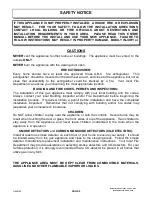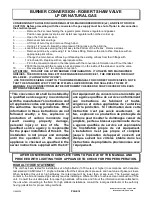
PAGE 10
OM-9703
Date Printed: Thursday, July 05, 2007
Revision Date: March 6, 2006
The appliance and venting should be inspected before use and annually afterwards by a qualified service
person.
More frequent cleaning may be required due to excessive lint from carpeting, bedding materials, etc.
It is imperative that control compartments, burners, and circulating air passageways of the appliance are kept
clean.
When cleaning the stove, make sure the appliance is off and cold. Remove the logs and embers and use a
vacuum to clean the burner and air openings in the bottom and at the back of the appliance. Replace the logs
and embers.
The draft hood must be in the same atmospheric pressure zone as the combustion air inlet. The flow of
combustion and ventilation air must not be obstructed.
Do not use this heater if any part has been under water. Immediately call a qualified service technician to
inspect the heater and to replace any part of the control system and any gas control which has been under
water.
CAUTION
As you plan your installation, consider the following:
The stove should be placed as centrally in the home as possible. Consider safety, convenience, traffic flow, and
the fact that the stove will need a venting system.
DUE TO HIGH TEMPERATURES, THE ROOM HEATER SHOULD BE LOCATED OUT OF
TRAFFIC
AREAS
AND
AWAY
FROM
FURNITURE
OR
DRAPERIES.
MINIMUM
CLEARANCES SHOWN ON PAGE 16 ARE TO PREVENT WALLS AND CEILINGS FROM
CATCHING ON FIRE.
See page 17 for the type of vent system to be used for both Freestanding Kit and Insert Kit. Power needed is
115-60 HZ. The stove is equipped with a fan assembly having a six foot electrical cord. Do not route the cord in
front of the stove.
Position the stove in its final location.
A floor protector may be used for aesthetics but is not
required. The freestanding 9703 units may be installed directly onto carpet, vinyl, or any other flooring.
WARNING
ONLY PERSONS LICENSED TO WORK WITH GAS PIPING MAY MAKE THE NECESSARY GAS CONNECTION TO THIS APPLIANCE.
YOU ARE NOW READY TO HOOK UP THE GAS SUPPLY. BE SURE GAS PLUMBING INSTRUCTIONS AND ALL PROVINCIAL AND
LOCAL CODES ARE CAREFULLY FOLLOWED. USE APPROVED FLEXIBLE GAS CONNECTIONS OR RIGID PIPING DEPENDING
ON STATE, PROVINCIAL AND LOCAL CODES TO ATTACH BURNER TO GAS SUPPLY. BE SURE TO USE PROPER SIZE GAS
SUPPLY LINE. CAREFULLY CHECK ALL CONNECTIONS WITH SOAP AND WATER SOLUTION FOR GAS LEAKS .
The installation must conform with local codes or, in the absence of local codes, with the
National Fuel Gas Code
,
ANSI A223.1/NFPA 54
, or the
Natural Gas and Propane Installation Code, CSA B149.1.
A manufactured home (USA only) or mobile home OEM installation must conform with the
Manufactured Home
Construction and Safety Standard
,
Title 24 CFR, Part 3280
, or, when such a standard is not applicable, the
Standard for
Manufactured Home Installations, ANSI/NCSBCS A225.1
, or Standard for
Gas Equipped
Recreational Vehicles and Mobile Housing, CSA Z240.4.
PLANNING YOUR STOVE PLACEMENT
INSERT:
If the hearth rises less than 6 inches above floor then R 1.1 protection or better is required at least
15 inches in front of, and spanning the width of the unit. This appliance is equipped with a safety control
system designed to protect against improper venting of combustion products.
FREE STANDING:
This appliance may be installed directly on carpeting, tile or other combustible materials.
This gas appliance must not be connected to a chimney flue serving a separate solid fuel burning appliance.
Periodic examination of the venting systems is required.
Before using propane, please see local codes when installing in a basement.
USE ONLY THE GLASS DOOR CERTIFIED WITH THIS APPLIANCE








































